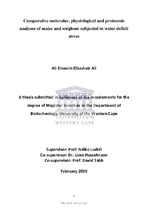| dc.description.abstract | Drought is a major abiotic stress which causes not only differences between the mean yield and the potential yield but also yield variation from year to year. Although selection for genotypes with improved productivity under drought environments has been a central goal of numerous plant breeding programs, the molecular basis for plant tolerance towards drought stress is still poorly understood. Exposure of plants to this abiotic stress is known to trigger excessive formation of reactive oxygen species (ROS), which induce cell death and reduce growth. Part of the mechanism of plant responses to drought involves alterations in the expression of antioxidant enzymes and biosynthesis of different compatible solutes such as proline. Sorghum is regarded as generally more drought tolerant than maize, and it is a potential key model system for investigating the physiological and molecular mechanisms conferring drought tolerance. Comparative studies in crop plants to decipher differences in drought tolerance are essential for crop improvement to sustain a higher level of production, which in turn will improve food security, under severe drought conditions resulting from climate change. On this basis, the aim of this study is to determine molecular differences between Zea mays and Sorghum bicolor in response to drought stress in an attempt to identify novel biomarkers for drought tolerance. The physiological and molecular responses of maize and sorghum were studied for changes in growth, chlorophyll content, relative water content, ROS content, lipid peroxidation level, proline content, and antioxidant enzyme activity. Spectral Count Label-free Quantitation analysis was conducted to reveal the changes in protein profiles under drought in attempt to identify drought-responsive molecular mechanisms in the leaves of the two plant species. In this study, water deficit triggered mechanisms that resulted in overproduction of ROS in both Zea mays and Sorghum bicolor. However, Sorghum bicolor showed less oxidative damage under water stress compared to Zea mays. Drought-induced proline accumulation in the roots of Sorghum bicolor was associated with enhanced water retention. Significant changes were identified in the antioxidant enzyme activity between the two plant species in response to drought conditions. Proteomics results showed differing patterns for drought-responsive proteins in the two species. Together with the physiological, biochemical and proteomic profiling results between Zea mays and Sorghum bicolor, potential proteins and/or metabolic pathways underlying drought tolerance were identified. The findings obtained through this study provide insight towards understanding the molecular basis of crop drought tolerance. | en_US |

